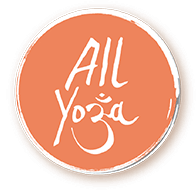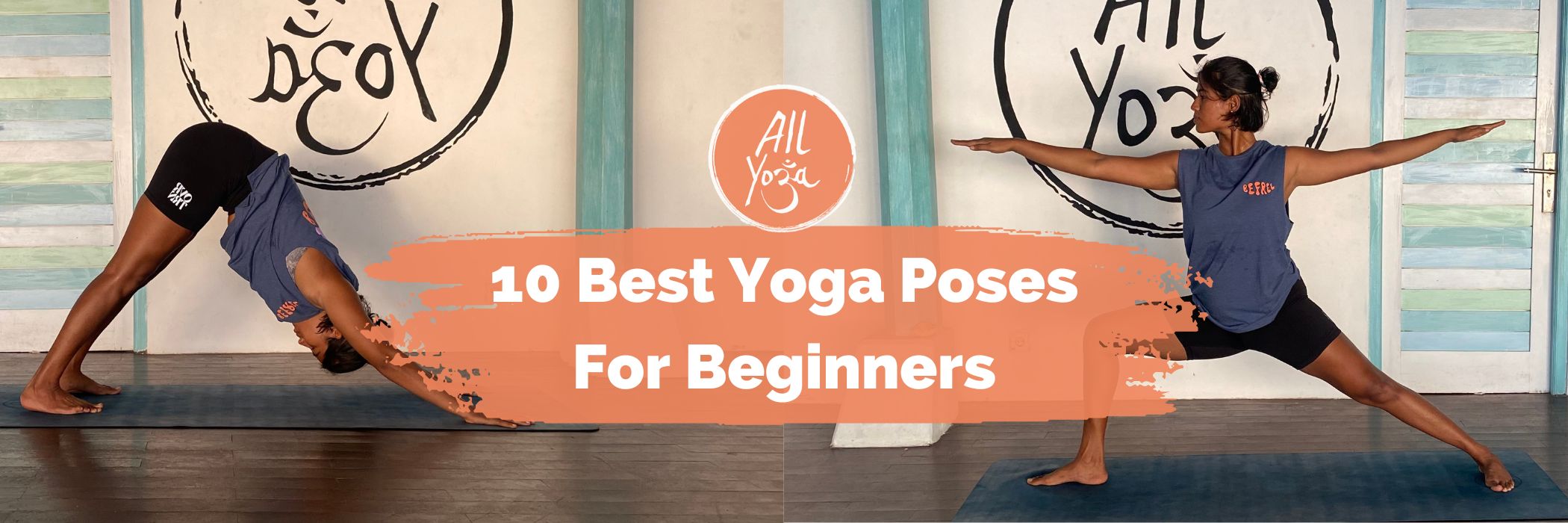Top 10 Yoga Poses for Beginners: A Guide to Get Started
Embarking on your yoga journey opens a world of benefits for both mind and body, and it all starts with mastering the basic beginner yoga poses. If you’re new to yoga, finding the right starting point can be as calming as a deep breath amidst tranquility. In this comprehensive guide, we introduce the “Top 10 Beginners Yoga Poses,” carefully selected to help you build a solid foundation in your practice.
From Downward Dog to Savasana, each pose has been chosen for its accessibility to beginners and its transformative benefits. Whether you’re looking to enhance flexibility, build strength, or find mental clarity, these beginner-friendly yoga poses are your first step towards a balanced and harmonious yoga practice.
Join us as we explore these foundational poses, offering step-by-step instructions and insights into how each can contribute to your wellness journey. Start your path to wellness today, and discover the transformative power of yoga poses for beginners.
1. Downward Facing Dog (Adho Mukha Svanasana)
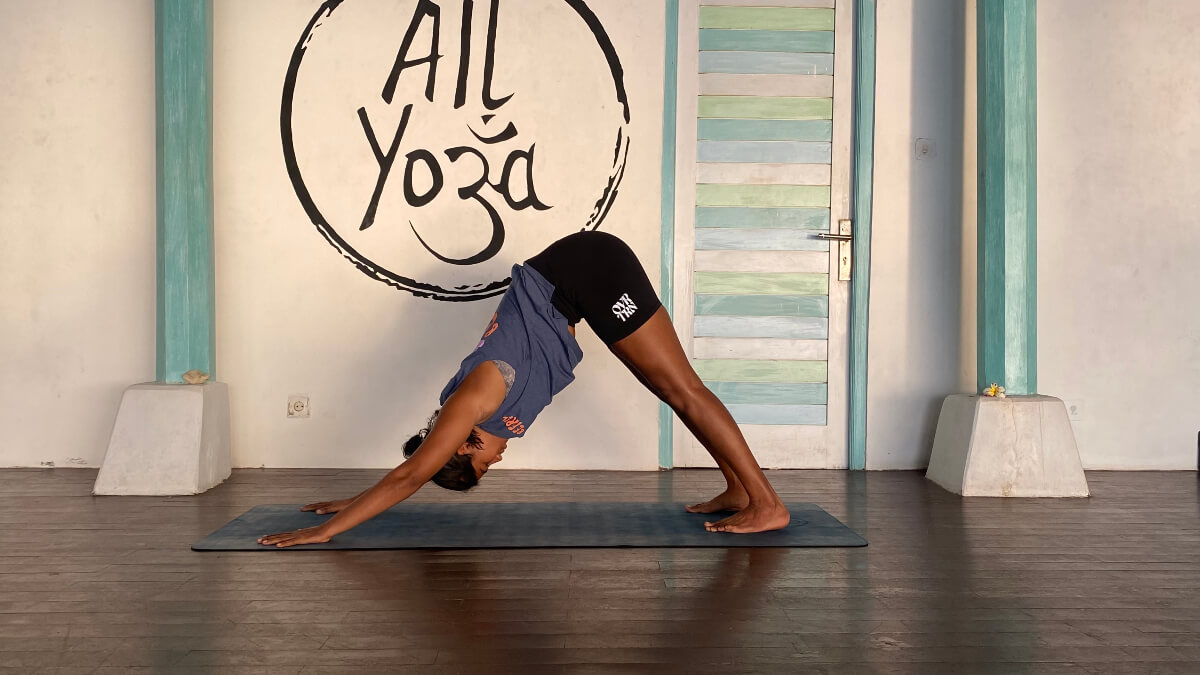
Benefits: Downward Facing Dog is a cornerstone pose in yoga, renowned for strengthening the entire body while calming the mind. This beginner yoga pose stretches the shoulders, hamstrings, calves, and hands, and can help relieve back pain by strengthening the core. Additionally, it improves circulation and energizes the body.
- Start on your hands and knees, with wrists aligned under shoulders and knees under hips.
- Spread your fingers wide, press into your palms, and lift your hips up and back.
- Straighten your legs as much as possible, with heels pushing towards the floor.
- Keep your head between your arms, gazing towards your feet.
- Hold the pose for 3-5 breaths, focusing on lengthening your spine and stretching your legs.
- All Yoga’s Tips for Beginners:
- If your hamstrings are tight, keep a slight bend in your knees.
- Ensure your weight is evenly distributed between your hands and feet.
- Practice against a wall to understand the alignment of hips over ankles.
2. Mountain Pose (Tadasana)
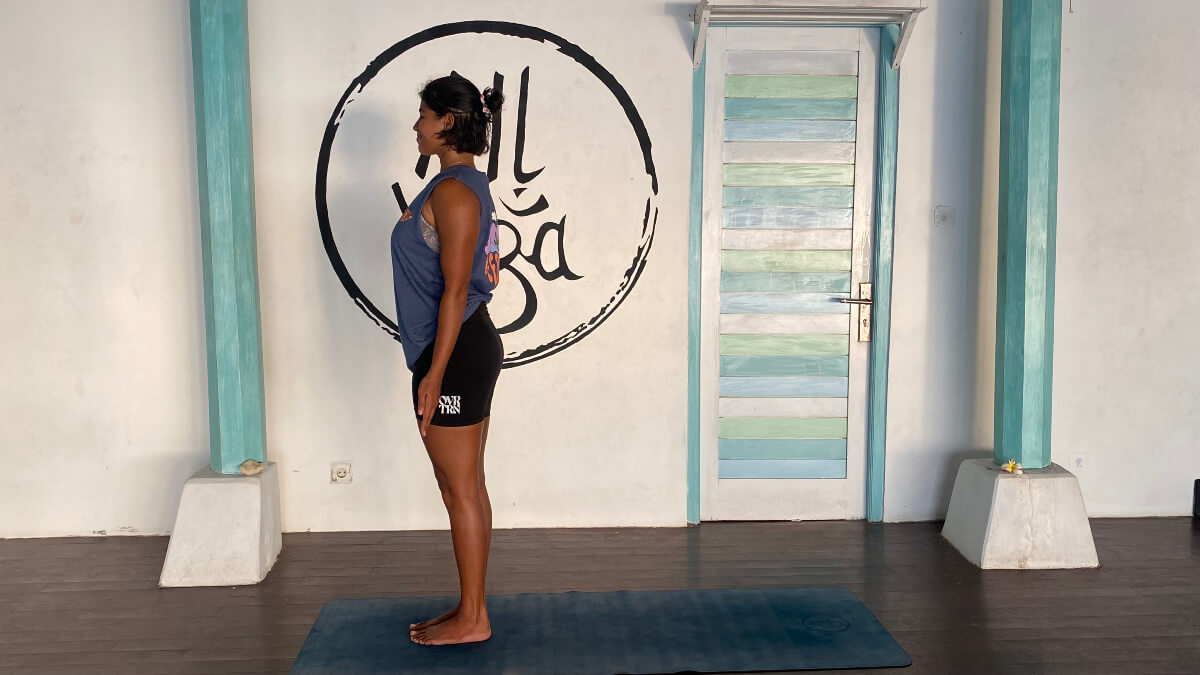
Benefits: Mountain Pose is the foundation of all standing poses, focusing on alignment, stability, and grounding. This beginner yoga pose helps improve posture, strengthens thighs, knees, and ankles, and stimulates the abdominal muscles.
- Stand with feet together, big toes touching, heels slightly apart, or hip-width for more stability.
- Engage your thigh muscles, lifting the kneecaps without hardening the lower belly.
- Lengthen your tailbone toward the floor and lift the crown of your head towards the sky.
- Keep arms at sides with palms facing forward.
- Breathe deeply and hold the pose for 30 seconds to 1 minute.
- All Yoga’s Tips for Beginners:
- Imagine a line of energy running through your body, connecting you to the earth and the sky.
- Practice in front of a mirror to check your alignment.
3. Warrior I (Virabhadrasana I)
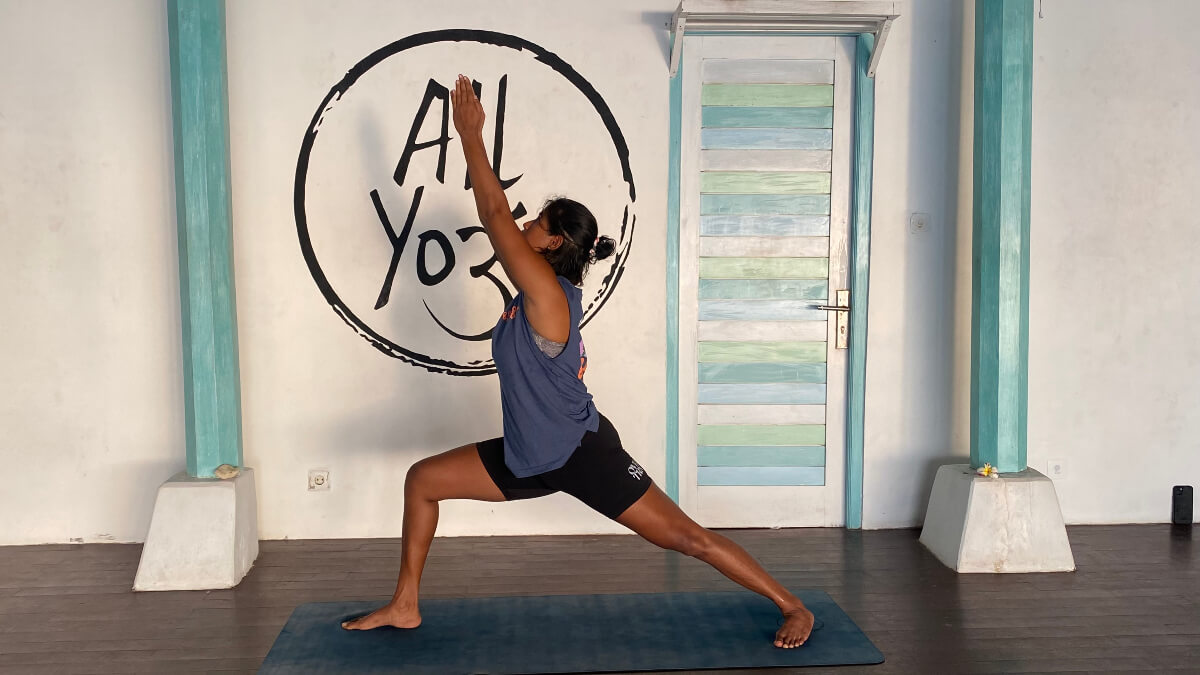
Benefits: Warrior I is a powerful pose that builds focus, power, and stability. This beginner yoga pose strengthens the shoulders, arms, legs, ankles, and back while improving flexibility in the hips and thighs.
- Begin in Mountain Pose, then step your feet about 4 to 5 feet apart.
- Raise your arms perpendicular to the floor and parallel to each other, palms facing each other.
- Turn your left foot in slightly to the right and your right foot out to the right 90 degrees.
- Align the right heel with the left heel.
- Exhale and rotate your torso to the right, squaring the front of your pelvis as much as possible with the front edge of your mat.
- Bend your right knee over the right ankle, so that the shin is perpendicular to the floor.
- Reach up strongly through your arms, lifting the ribcage away from the pelvis.
- Hold the pose for up to a minute, then release and repeat on the opposite side.
- All Yoga’s Tips for Beginners:
- Use a wall to support your back heel if balancing is difficult.
- Ensure your front knee doesn’t go beyond your toes to avoid strain.
4. Warrior 2 (Virabhadrasana II)
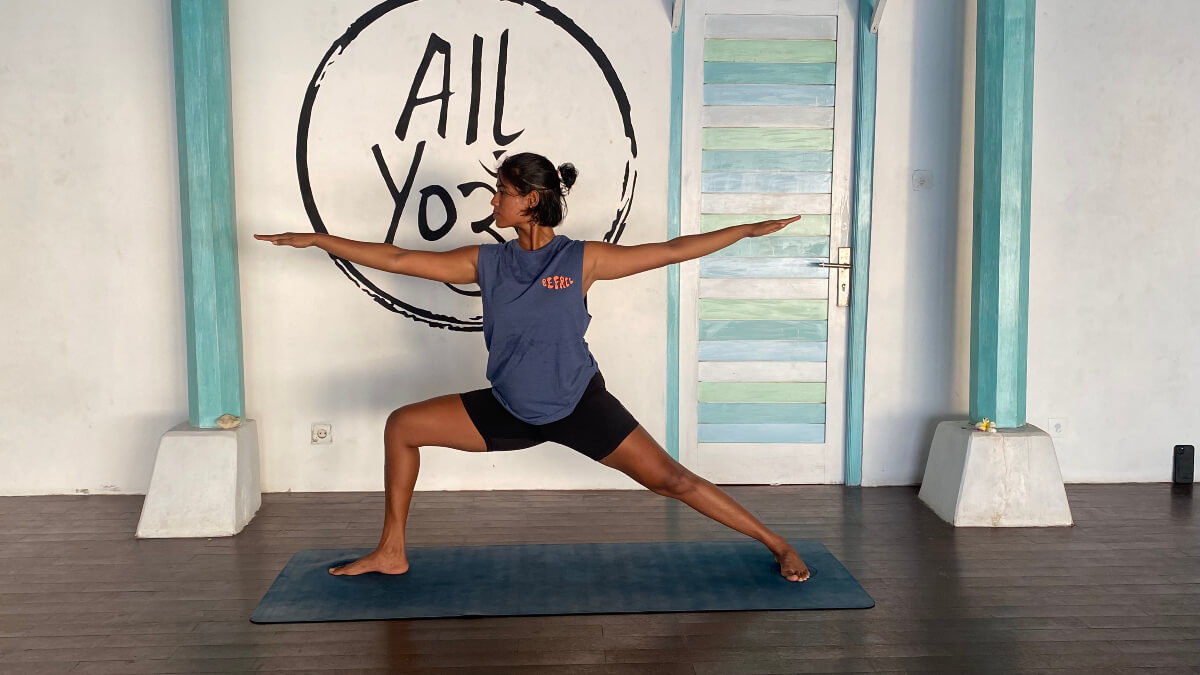
Benefits: Warrior 2 enhances stamina and concentration, stretching the hips, groins, and shoulders. This beginner yoga pose tones the legs, abdomen, and glutes while aiding in improving balance and stability.
- Start from a standing position and step your feet 4-5 feet apart.
- Raise your arms to the sides to shoulder height, palms facing down.
- Turn your right foot out 90 degrees and your left foot in about 45 degrees.
- Bend your right knee until your right thigh is parallel to the floor, keeping your knee directly over your ankle.
- Gaze out over your right hand, keeping your torso even between the hips.
- Stay in this pose for 30 seconds to 1 minute, then switch sides and repeat.
- All Yoga’s Tips for Beginners:
- Ensure your front thigh is parallel to the floor; adjust your stance width if necessary.
- Keep your back leg actively engaged and straight.
5. Triangle Pose (Utthita Trikonasana)
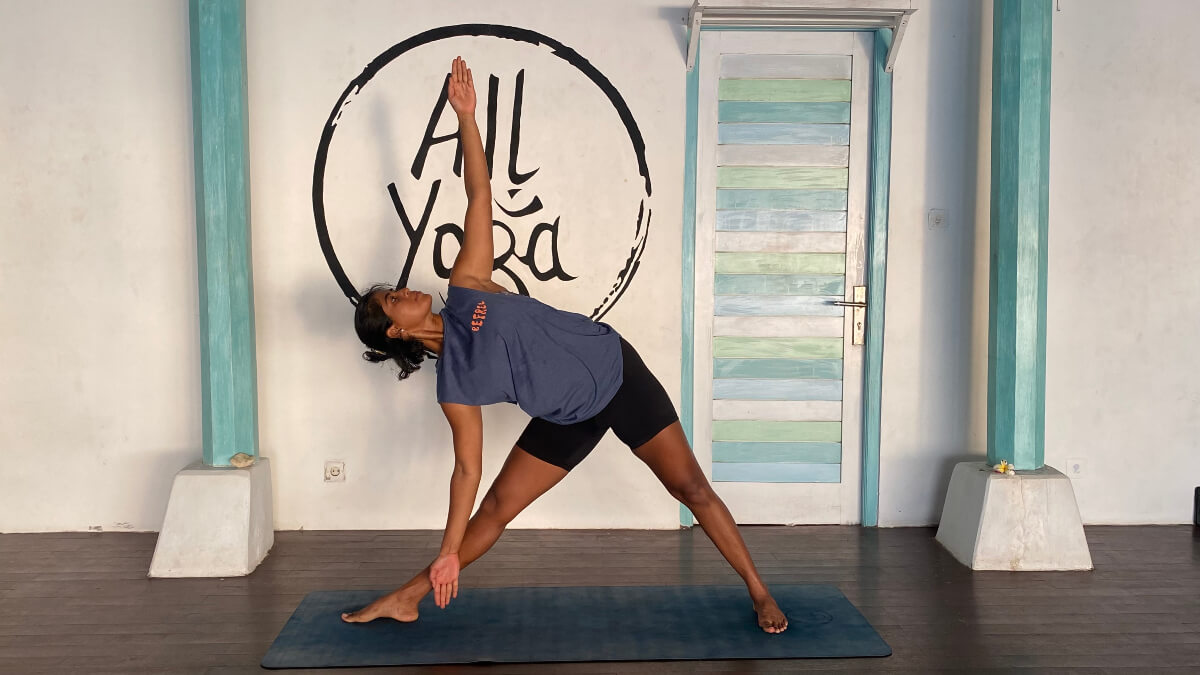
Benefits: Triangle Pose stretches and strengthens the thighs, knees, ankles, hips, groins, hamstrings, and spine. This beginner yoga pose also opens the chest and shoulders, improving digestion and relieving stress.
- Begin in a wide stance, feet about 4 feet apart, arms extended at shoulder height.
- Turn your right foot out 90 degrees and your left foot in slightly.
- Extend your torso to the right, directly over the right leg as you bend from the hip, not the waist.
- Place your right hand on your ankle, shin, or the floor outside your right foot, whichever is accessible.
- Stretch your left arm toward the ceiling, in line with the tops of your shoulders. Keep your head in a neutral position or turn it to look up at your left hand.
- Hold the pose for 30 seconds to 1 minute, then inhale to come up and repeat on the opposite side.
- All Yoga’s Tips for Beginners:
- Use a block under your lower hand if you cannot reach the floor comfortably.
- Keep both legs straight and firm; do not lock your knees.
6. Tree Pose (Vrksasana), beginner yoga pose
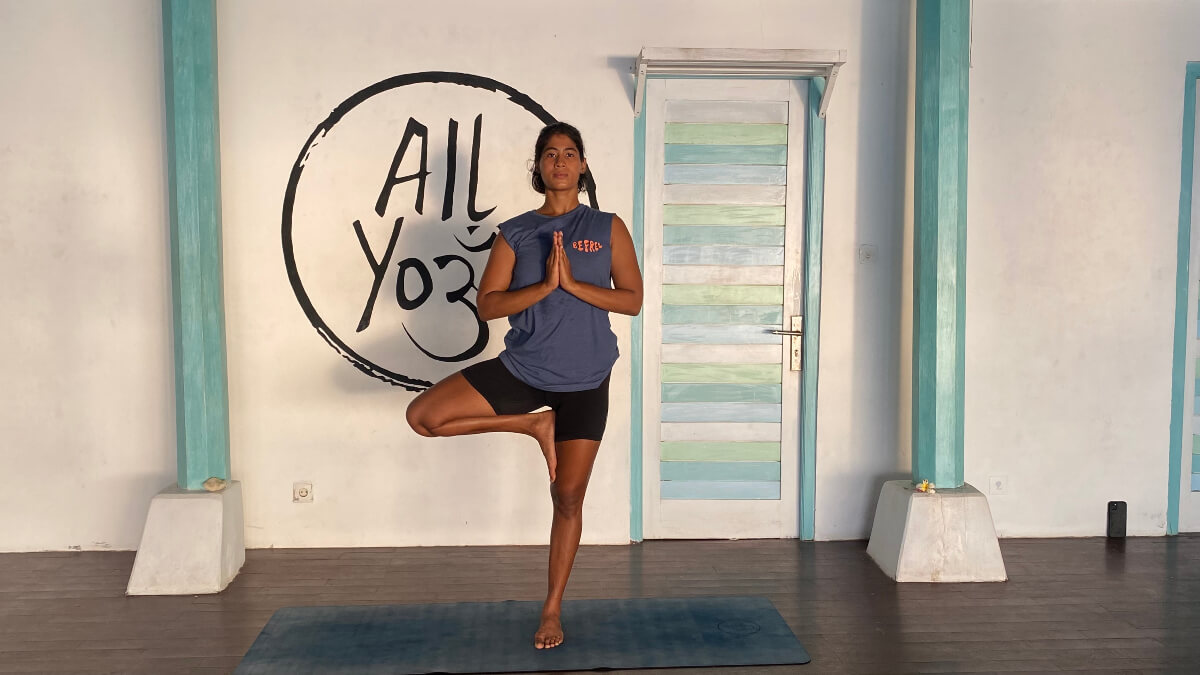
Benefits: Tree Pose strengthens your thighs, calves, ankles, and spine, while stretching the groins and inner thighs, chest, and shoulders. It improves sense of balance, focus, and concentration, promoting mental and physical equilibrium.
- Start in Mountain Pose. Shift your weight slightly onto your left foot, keeping the inner foot firm to the floor.
- Bend your right knee and place your right foot on your left inner thigh, calf, or ankle, with the toes pointing downward.
- Press your right foot into your left thigh and bring your hands to prayer position at your chest.
- When you feel balanced, extend your arms over your shoulders, palms facing each other or touching.
- Focus on a fixed point in front of you for 30 seconds to 1 minute.
- Lower your arms and leg back to Mountain Pose and repeat on the other side.
- All Yoga’s Tips for Beginners:
- If balancing is difficult, practice next to a wall for support.
- Avoid placing your foot directly on the knee joint to prevent strain.
7. Cobra Pose (Bhujangasana), beginner yoga pose
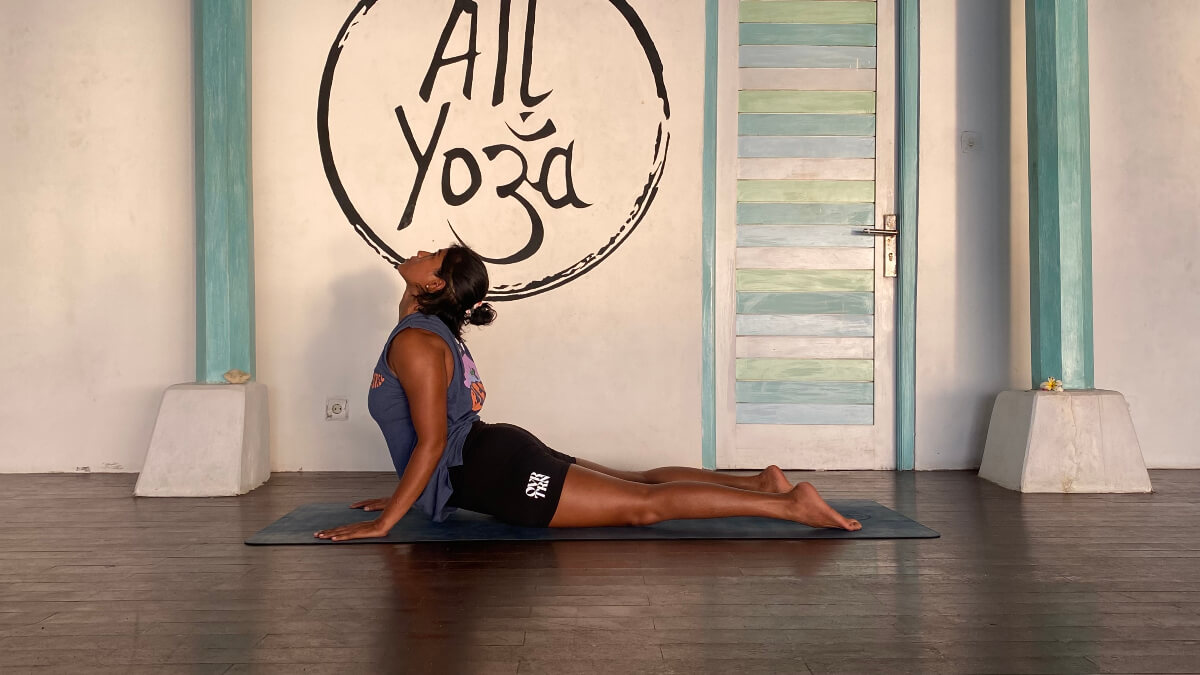
Benefits: Cobra Pose strengthens the spine, stretches chest and lungs, shoulders, and abdomen. This yoga pose for beginners also helps to reduce stress and fatigue, stimulates abdominal organs, and opens the heart and lungs.
- Lie prone on the floor, stretch your legs back, tops of the feet on the floor, and place your hands under your shoulders.
- Hug the elbows back into your body.
- Press the tops of the feet and thighs and the pubis firmly into the floor.
- On an inhalation, begin to straighten the arms to lift the chest off the floor, going only to the height at which you can maintain a connection through your pubis to your legs.
- Hold the pose for 15-30 seconds, breathing easily.
- Release back to the floor with an exhalation.
- All Yoga’s Tips for Beginners:
- Do not overextend your arms; keep a slight bend in the elbows.
- Engage your back muscles more than your arms to lift up.
8. Bridge Pose (Setu Bandhasana), beginner yoga pose
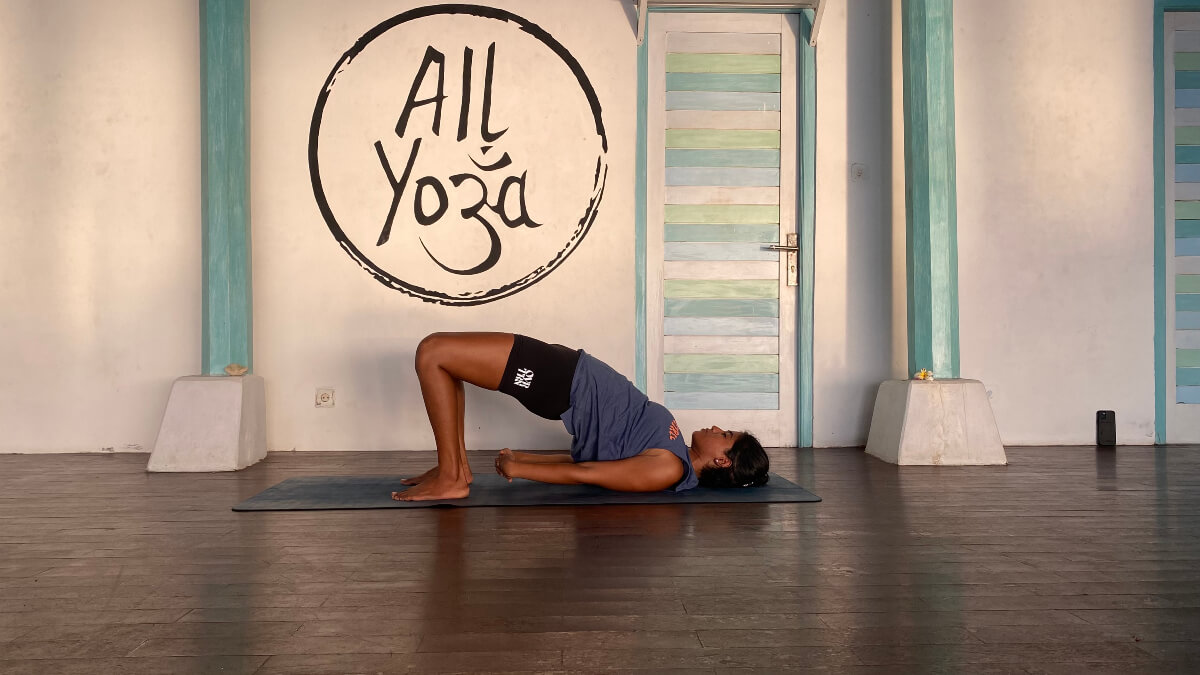
Benefits: Bridge Pose stretches the chest, neck, spine, and hips. This yoga pose for beginners strengthens the back, buttocks, and hamstrings, improves circulation of blood, and may help alleviate stress and mild depression.
- Lie on your back with knees bent and feet flat on the floor, hip-width apart, close to your sitting bones.
- Place your arms at your side with palms down.
- Press your feet and arms firmly into the floor and lift your hips toward the ceiling.
- Keep your thighs and feet parallel. Clasp your hands under your lower back and extend through your arms to help you stay on the tops of your shoulders.
- Hold the pose for up to 1 minute.
- Release the pose by slowly rolling the spine back onto the floor.
- All Yoga’s Tips for Beginners:
- Use a block under your sacrum for support if you’re having difficulty holding the pose.
- Keep your knees aligned with your hips and do not splay to the side.
9. Child’s Pose (Balasana), beginner yoga pose
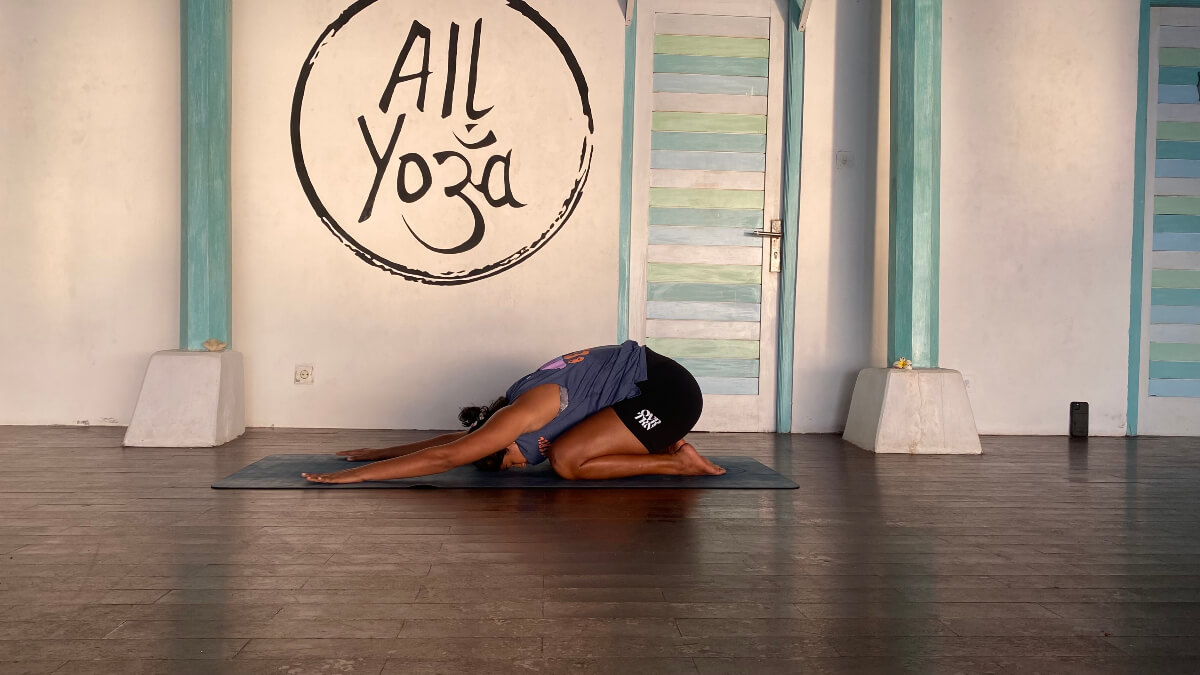
Benefits: Child’s Pose helps to stretch the hips, thighs, and ankles while reducing stress and fatigue. This yoga pose for beginners gently relaxes the muscles on the front of the body while softly stretching the muscles of the back torso.
- Kneel on the floor, touch your big toes together, and sit on your heels. Then, separate your knees about as wide as your hips.
- Exhale and lay your torso down between your thighs.
- Lay your hands on the floor alongside your torso, palms up, and release the fronts of your shoulders toward the floor.
- Stay anywhere from 30 seconds to a few minutes.
- To come up, first lengthen the front torso, and then with an inhalation, lift from the tailbone as it presses down and into the pelvis.
- All Yoga’s Tips for Beginners:
- If your buttocks don’t reach your heels, place a folded blanket or pillow between your thighs and calves.
- Breathe deeply into your back, expanding the back ribs and waist.
10. Corpse Pose (Savasana), beginner yoga pose
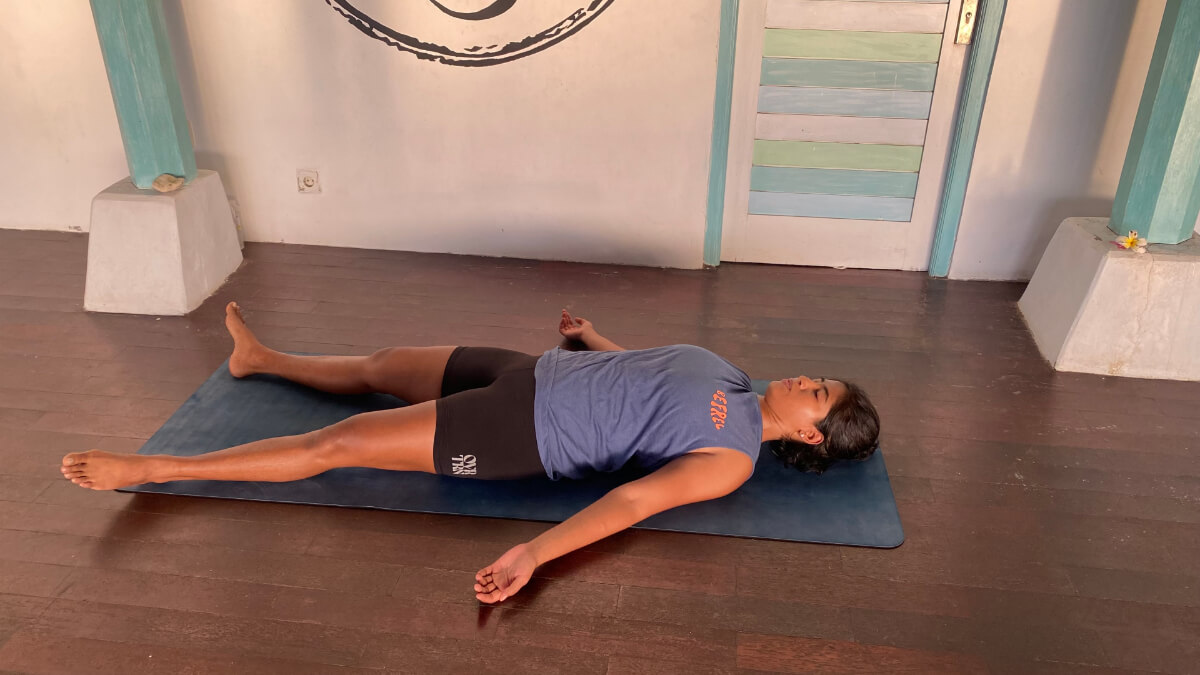
Benefits: Corpse Pose promotes deep healing and relaxation, allowing the body to integrate the benefits of the yoga practice. This yoga pose for beginners helps to relieve stress and can improve mental well-being, promoting a deep meditative state of rest.
- Lie on your back, letting your feet fall open, and arms relax at your sides, palms facing up.
- Close your eyes and take a deep breath in through your nose. As you exhale, allow your body to feel heavy on the ground.
- Relax every part of your body from your face to your toes, focusing on releasing tension with each exhale.
- Stay in this pose for 5-10 minutes, maintaining stillness and deep, steady breaths.
- To come out, gently wiggle your fingers and toes, roll to one side, then slowly sit up.
- All Yoga’s Tips for Beginners:
- If your lower back is uncomfortable, place a rolled blanket or bolster under your knees.
- Cover yourself with a blanket for warmth and comfort if needed.
Conclusion
As we wrap up our exploration of the Top 10 Yoga Poses for Beginners, it’s clear that the journey into yoga is as much about inner discovery as it is about physical flexibility and strength. Starting with foundational poses like the Mountain Pose and progressing through to the restorative peace of the Corpse Pose (Savasana), each step on this path offers its unique blend of challenges and rewards. Remember, the beauty of yoga lies in the journey, not just the destination.
By incorporating these beginner yoga poses into your routine, you’re not only building a stronger body but also fostering a more resilient, calm, and focused mind. We encourage you to practice these poses regularly, listen to your body, and embrace the transformative journey of yoga with an open heart and mind. Whether you’re practicing at home or in a class, these poses will serve as a solid foundation for your continued exploration of yoga. Keep exploring, keep practicing, and let the journey of yoga enrich your life in countless ways. Namaste.
FAQ
How do I start yoga at home for beginners?
Create a comfortable space free of distractions and choose a beginner-friendly yoga video or app to guide your practice. Begin with basic poses to build your foundation, focusing on your breath and form. Practice regularly, listening to your body’s needs and limitations, and gradually increase the complexity of poses as you gain more confidence and flexibility.
How many times a week should a beginner do yoga?
Aim to practice yoga 2-3 times a week to see progress in flexibility, strength, and mental wellness. This frequency allows your body to adapt to the new practice while providing adequate rest. As you become more comfortable, you can increase the frequency according to your goals and schedule.
How do I prepare for a beginner yoga class?
To prepare for a beginner yoga class, wear comfortable clothing that allows for a full range of motion. Bring a yoga mat, water bottle, and an open mind. Arrive a few minutes early to settle in and inform the instructor of any injuries or concerns. Focus on your own practice, not on what others are doing, and remember that yoga is a personal journey!
Can you lose weight with beginner yoga?
Absolutely! Beginner yoga can contribute to weight loss by improving your metabolism, reducing stress, and building lean muscle mass. While yoga is often more gentle than high-intensity workouts, it can still help create a calorie deficit when combined with a balanced diet and consistent practice. Different styles and a gradual increase in intensity can enhance these benefits further.
Read More Blogs
Want to Become a Yoga Teacher and/or
Deepen your Yoga Practice?
2 FREE EBOOKS FOR YOU:
- 20 things to know before choosing a yoga teacher training
- 7 tips to deepen your yoga practice right now
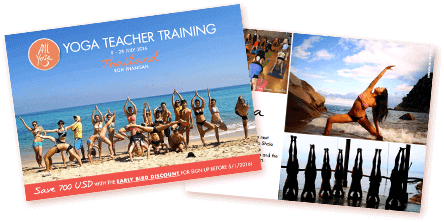
Copyright © 2024, All Yoga International ltd. All Rights Reserved
Privacy Policy